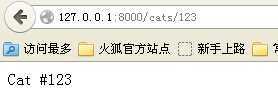标签:style blog http io color ar sp 数据 div
写你的第一个routes(路由)
在我们的app/routes.php添加两个路由
1 Route::get(‘/‘, function() 2 { 3 return "All cats"; 4 }); 5 6 Route::get(‘cats/{id}‘,function($id){ 7 return "Cat #$id"; 8 });
get方法的第一个参数是url模式,当模式被匹配到,就会执行一个带参数的(在匹配到的模式中提取)闭包函数(get的第二个参数)。
限制路由参数
在我们的第二个路由中,{id}匹配任何的字符和数字。我们要限制它只能匹配数字,我们可以链一个where方法在我们的路由中
1 Route::get(‘cats/{id}‘,function($id){ 2 return "Cat #$id"; 3 })->where(‘id‘,‘[0-9]+‘);
where方法带两个参数,第一个是参数的名字,第二个是一个正则表达式
访问看看


设置错误页面,我们可以通过catch一个“NOT FOUND”异常来显示我们自定义的错误页面。在app/start/global.php定义missing方法:
1 App::missing(function($exception){ 2 return Response::make("Page Not Found!by jy pong",404); 3 });
我们这里不仅仅返回一个字符串,而是一个Response对象带一个字符串信息作为第一个参数,HTTP状态码作为第二个参数。

重定向
我们可以通过Redirect对象来重定向。
1 Route::get(‘/‘, function() 2 { 3 return Redirect::to(‘cats‘); 4 }); 5 Route::get(‘cats‘,function(){ 6 return "All cats!!"; 7 });
返回一个视图
我们最经常返回的对象是View对象。Views从路由(route)当中(或者控制器controller)得到数据,然后注入到模板中。在app/views中建立一个about.php
<h2>About this site</h2> There are over <?php echo $number_of_cats; ?> cats on this site!
通过View::make方法带一个变量$number_of_cats 返回一个view视图
1 Route::get(‘about‘, function(){ 2 return View::make(‘about‘)->with(‘number_of_cats‘,400); 3 });

标签:style blog http io color ar sp 数据 div
原文地址:http://www.cnblogs.com/jypwn/p/4058174.html